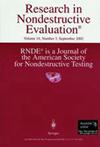涡流无损检测分析的ACA与插值混合方法
IF 1
4区 材料科学
Q3 MATERIALS SCIENCE, CHARACTERIZATION & TESTING
引用次数: 3
摘要
本文提出了自适应交叉逼近(ACA)算法与基于插值的核函数分离的杂交方法,以加速求解三维任意形状涡流无损评价问题的边界元法(BEM)所产生的矩阵方程。该混合方法结合了ACA算法和基于插值的方法的优点,解决了纯ACA方法在平面涡流无损评价问题建模时,无法压缩检测贴片和基贴片共面时边界元生成的空项的缺点。在该方法中,与空条目相关的子矩阵通过基于插值的方法进行压缩,而其他子矩阵则通过ACA算法进行压缩。几个基准测试证明了所提出的快速通用求解器的鲁棒性和效率。本文章由计算机程序翻译,如有差异,请以英文原文为准。
Hybrid Method of ACA and Interpolation-based Algorithms for Analysis of Eddy Current Nondestructive Evaluations
In this article, the hybridization of adaptive cross approximation (ACA) algorithm and interpolation-based separation of the kernel function is proposed to accelerate solving the matrix equations resulted in the boundary element method (BEM) for 3D arbitraryshaped eddy current nondestructive evaluation problems. The hybrid method combines the advantages of both the ACA algorithm and the interpolation-based methods, and resolves the shortcoming of pure ACA method, when modeling the planar eddy current nondestructive evaluation problems, that it cannot compress the null entries the BEM generated when the testing and basis patches are co-planar. In the proposed method, the submatrices associated with the null entries are compressed by the interpolation-based method, while the others are compressed by the ACA algorithm. Several benchmarks are shown to demonstrate both the robustness and efficiency of the proposed fast and general solver.
求助全文
通过发布文献求助,成功后即可免费获取论文全文。
去求助
来源期刊

Research in Nondestructive Evaluation
工程技术-材料科学:表征与测试
CiteScore
2.30
自引率
0.00%
发文量
14
审稿时长
>12 weeks
期刊介绍:
Research in Nondestructive Evaluation® is the archival research journal of the American Society for Nondestructive Testing, Inc. RNDE® contains the results of original research in all areas of nondestructive evaluation (NDE). The journal covers experimental and theoretical investigations dealing with the scientific and engineering bases of NDE, its measurement and methodology, and a wide range of applications to materials and structures that relate to the entire life cycle, from manufacture to use and retirement.
Illustrative topics include advances in the underlying science of acoustic, thermal, electrical, magnetic, optical and ionizing radiation techniques and their applications to NDE problems. These problems include the nondestructive characterization of a wide variety of material properties and their degradation in service, nonintrusive sensors for monitoring manufacturing and materials processes, new techniques and combinations of techniques for detecting and characterizing hidden discontinuities and distributed damage in materials, standardization concepts and quantitative approaches for advanced NDE techniques, and long-term continuous monitoring of structures and assemblies. Of particular interest is research which elucidates how to evaluate the effects of imperfect material condition, as quantified by nondestructive measurement, on the functional performance.
 求助内容:
求助内容: 应助结果提醒方式:
应助结果提醒方式:


